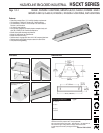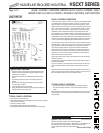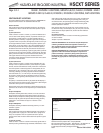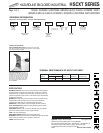
HAZARDLINE ENCLOSED INDUSTRIAL HSCXT SERIES
Page 3 of 4 CLASS I, DIVISION 2 LOCATIONS, GROUPS A,B,C,D; CLASS II, DIVISION I AND 2
GROUPS F AND G; CLASS III, DIVISION I, DIVISION 2 LOCATIONS, WET LOCATIONS
Job Information Type:
Job Name:
Cat. No.:
Lamp(s):
Volts/Ballast:
Lightolier a Genlyte Thomas Company www.lightolier.com
Technical Information: (978) 657-7600 • Fax (978) 658-0595
631 Airport Road, Fall River, MA 02720 • (508) 679-8131 • Fax (508) 674-4710
We reserve the right to change details of design, materials and finish.
© 2002 Genlyte Thomas Group LLC (Lightolier Division)
A0902 Section 7/Folio Q10-33
IGNITIBLE DUST LOCATIONS
The following hazardous location definitions pertinent to HAZARDLINE are
excerpted from Article 500 of the 1990 National Electrical Code.
Class II Locations
Class II locations are those that are hazardous because of the presence of
combustible dust. Class II locations shall include those specified in (a) and
(b) below.
(a) Class II, Division 1
A Class II, Division 1 location is a location; (1) in which combustible dust is
in the air under normal operating conditions, in quantities sufficient to pro-
duce explosive or ignitible mixtures; or (2) where mechanical failure or
abnormal operation of machinery or equipment might cause such explosive
or ignitible mixtures to be produced, and might also provide a source of igni-
tion through simultaneous failure of electrical equipment, operation of pro-
tection devices, or from other causes; or (3) in which combustible dusts of
an electrically conductive nature may be present in hazardous quantities.
Combustible dusts which are electrically nonconductive include dusts pro-
duced in the handling and processing of grain and grain products, pulverized
sugar and cocoa, dried egg and milk powders, pulverized spices, starch and
pastes, potato and woodflour, oil meal from beans and seed, dried hay, and
other organic materials which may produce combustible dusts when
processed or handled. Electrically conductive dusts are dusts with a resistiv-
ity less than 10
5
ohm-centimeter.
(b) Class II, Division 2
A Class II, Division 2 location is a location where combustible dust is not
normally in the air in quantities sufficient to produce explosive or ignitible
mixtures, and dust accumulations are normally insufficient to interfere with
the normal operation of electrical equipment or other apparatus, but com-
bustible dust may be in suspension in the air as a result of infrequent mal-
functioning of handling or processing equipment and where combustible
dust accumulations on, in, or in the vicinity of the electrical equipment may
be sufficient to interfere with the safe dissipation of heat from electrical
equipment or may be ignitible by abnormal operation or failure of electrical
equipment.
The quantity of combustible dust that may be present and the adequacy of
dust removal systems are factors that merit consideration in determining the
classification and may result in an unclassified area.
Where products such as seed are handled in a manner which produces low
quantities of dust, the amount of dust deposited may not warrant classifica-
tion.
Group F Atmospheres:
Atmospheres containing carbon black, charcoal, coal or coke dusts which
have more than 8 percent total volatile material (coal and coke dusts per
ADTM 3175-82) or atmospheres containing these dusts sensitized by other
materials so that they present an explosion hazard, and having resistivity
greater than 10
2
ohm-centimeter but equal to or less than 10
8
ohm-
centimeter.
Group G Atmospheres:
Atmospheres containing combustible dusts having resistivity of 10
8
ohm-
centimeter or greater.
Class III Locations
Class III locations are those that are hazardous because of the presence of
easily ignitible fibers of flyings, but in which such fibers or flyings are not
likely to be in suspension in the air in quantities sufficient to produce
ignitible mixtures. Class III locations shall include those specified in (a) and
(b) below.
(a) Class III, Division 1
A Class III, Division 1 location is a location in which easily ignitible fibers or
materials producing combustible flyings are handled, manufactured, or used.
Such locations usually include some parts of rayon, cotton, and other textile
mills; combustible fiber manufacturing and processing plants; cotton gins
and cotton-seed mills; flax-processing plants, clothing manufacturing plants;
woodworking plants; and establishments and industries involving similar
hazardous processes or conditions.
Easily ignitible fibers and flyings include rayon, cotton (including cotton lin-
ters and cotton waste), sisal or henequen, istle, jute, hemp, tow, cocoa fiber,
oakum, baled waste kapok, Spanish moss, excelsior and other materials of
similar nature.
(b) Class III, Division 2
A Class III, Division 2 location is a location in which easily ignitible fibers
are stored or handled.
Exception: In process of Manufacture.
CAUTION: HAZARDLINE is not UL-listed for Group E: Atmospheres
containing combustible metal dusts regardless of resistivity, or
other combustible dusts of similarly hazardous characteristics hav-
ing resistivity of less than 10
2
ohm-centimeter.
CAUTION: HAZARDLINE Class I, Division 2 is not listed for Division 1
applications where the hazardous atmosphere is expected to be
present continuously or periodically during normal operations or
frequently because of repair or maintenance operations. For such
locations, only appropriate UL-listed explosion-proof equipment is
permitted.






